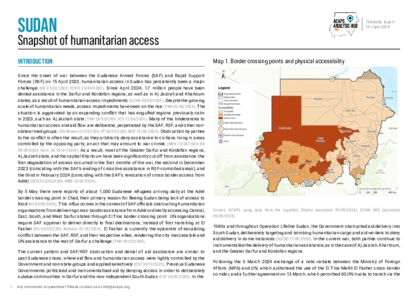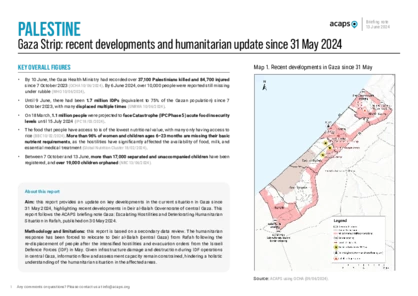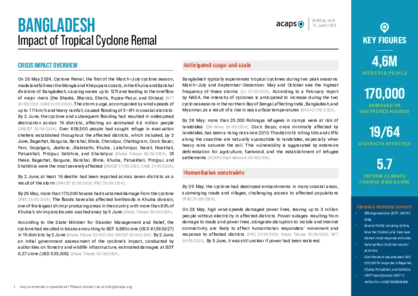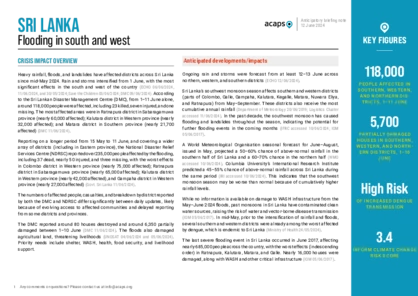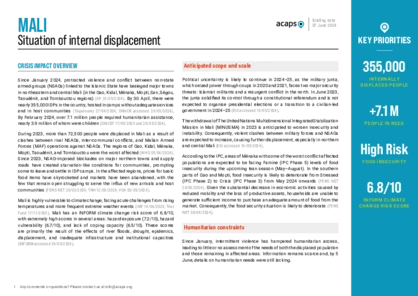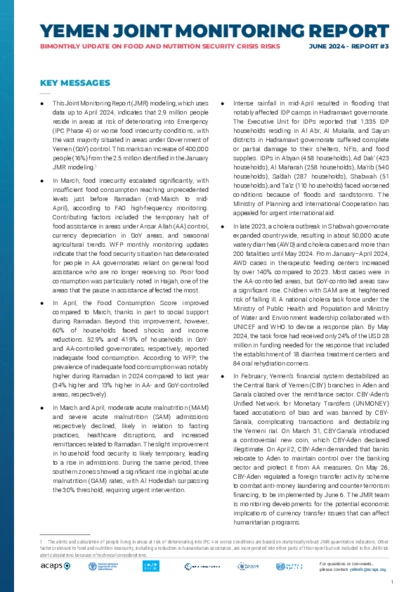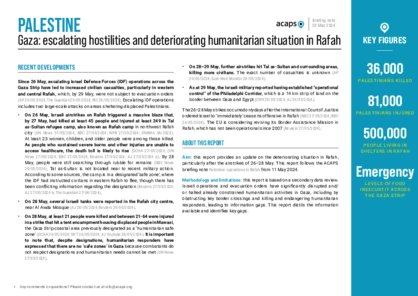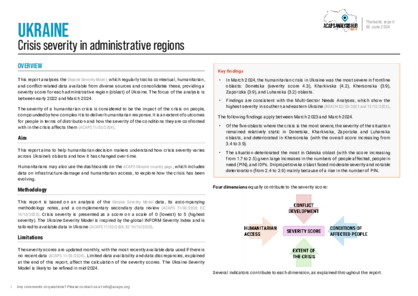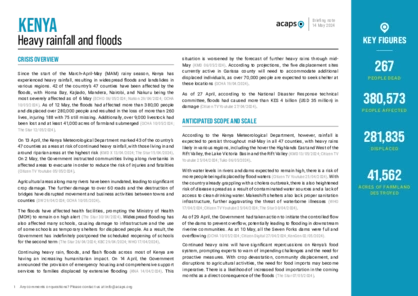Explore our
analysis products
archive
19 June 2024
Sudan: snapshot of humanitarian access
DOCUMENT / PDF / 5 MB
This report aims to highlight Sudan’s current access situation, using a regional focus to account for regions’ markedly different access situations.
Attached resources
14 June 2024
Yemen: Voices from Khanfar district - understanding household challenges and coping strategies
DOCUMENT / PDF / 6 MB
This report aims to outline the strategies that households use to meet their needs and identify effective coping strategies that could be reinforced through humanitarian programming, as well as strategies with negative impacts that are currently not being reduced or mitigated.
Attached resources
13 June 2024
Palestine: recent developments in the Gaza Strip
DOCUMENT / PDF / 369 KB
This report provides an update on key developments in the current situation in Gaza since 31 May 2024, highlighting recent developments in Deir al-Balah Governorate of central Gaza. It follows the ACAPS briefing note Gaza: escalating hostilities and deteriorating humanitarian situation in Rafah, published on 30 May 2024.
12 June 2024
Afghanistan: Risk updates since January 2024
DOCUMENT / PDF / 196 KB
This is an update of the Afghanistan: Key risk areas to watch: January – June 2024 and beyond. It considers how each risk area has developed since January and assesses whether the identified risks have materialised or whether their probability levels have increased, decreased, or remained the same.
12 June 2024
Greece: humanitarian access & conditions along the eastern Mediterranean mixed migration route
DOCUMENT / PDF / 2 MB
This report aims to provide an overview of the protection and humanitarian needs and challenges along the mixed migration route in Greece. It also aims to provide an overview of the barriers hindering humanitarian access and response to the mixed migration crisis in the country.
Attached resources
12 June 2024
Bangladesh: impact of tropical cyclone remal
DOCUMENT / PDF / 381 KB
On 26 May 2024, Cyclone Remal, the first of the March-July cyclone season, made landfall near the Mongla and Khepupara coasts, in the Khulna and Barishal divisions of Bangladesh. By 2 June, the cyclone and subsequent flooding had resulted in widespread destruction across 19 districts, affecting an estimated 4.6 million people.
07 June 2024
Mali: Situation of internal displacement
DOCUMENT / PDF / 527 KB
Since January 2024, protracted violence and conflict between non-state armed groups (NSAGs) linked to the Islamic State have besieged major towns in northeastern and central Mali (in the Gao, Kidal, Ménaka, Mopti, San, Ségou, Taoudénit, and Tombouctou regions)
Attached resources
06 June 2024
Haiti: Criminal gang violence in Port-au-Prince
DOCUMENT / PDF / 1 MB
This report provides an update on the surge in violence in the ZMPAP in the first half of 2024, highlighting the aggravation of needs and challenges accessing basic services. The report also provides an outlook section, giving insight into how the situation could evolve in the coming weeks.
05 June 2024
Yemen: Bimonthly update on food and nutrition security risks - issue 3
DOCUMENT / PDF / 2 MB
The Joint Monitoring Report (JMR) combines quantitative modeling and qualitative analysis to provide robust bimonthly food and nutrition security monitoring to identify emerging food and nutrition security crisis risks.
31 May 2024
Papua New Guinea: humanitarian impact of landslide in Lagaip - Porgera district
DOCUMENT / PDF / 961 KB
On 24 May 2024, at 03:00 local time, heavy rains contributed to a landslide in Lagaip-Porgera district, Enga province, with the most severe effects in and around Yambali Ward. Up to 8m of soil and rubble buried people, homes, infrastructure, and farmland and damaged the sole road leading to Yambali.
30 May 2024
Palestine: Gaza - escalating hostilities and deteriorating humanitarian situation in Rafah
DOCUMENT / PDF / 1 MB
This report provides an update on the deteriorating situation in Rafah, particularly after the airstrikes of 26–28 May. This report follows the ACAPS briefing note Palestine: operations in Rafah from 11 May 2024.
28 May 2024
Global increase of cholera: aggravated by vaccine shortage and El Niño
DOCUMENT / PDF / 341 KB
This report highlights the key contributing factors and aggravating conditions that can increase the global prevalence of cholera, focusing particularly on the impact of the global OCV shortage that is heightening humanitarian needs among affected populations and those vulnerable to spread.
Attached resources
27 May 2024
Ukraine: crisis severity in administrative regions
DOCUMENT / PDF / 6 MB
This report analyses the Ukraine Severity Model, which regularly tracks contextual, humanitarian, and conflict-related data available from diverse sources and consolidates these, providing a severity score for each administrative region (oblast) of Ukraine. The focus of the analysis is between early 2022 and March 2024.
22 May 2024
Niger: cross-border displacement in Agadez, Maradi, Diffa, and Tillaberi regions
DOCUMENT / PDF / 2 MB
Niger has become a country of transit and destination for people on the move. Until 3 May, Niger was hosting around 417,000 refugees and asylum seekers, primarily from Nigeria (over 57%) and Mali (over 31%), with the remaining hailing from various other countries, including Burkina Faso, Chad, and Sudan.
Attached resources
22 May 2024
Sudan: Impact of long-term displacement in the North
DOCUMENT / PDF / 1 MB
Since 15 April 2023, clashes between the Sudanese Armed Forces (SAF) and the Rapid Support Forces (RSF), a paramilitary group, have caused widespread displacement. IDPs are moving northwards into River Nile and Northern states, which offer security and potential routes to leave the country altogether.
Attached resources
21 May 2024
Afghanistan: impact of flooding
DOCUMENT / PDF / 1 MB
Above-average precipitation and extreme rainfall events, mainly attributable to the combined effects of El Niño and climate change, have been triggering floods, flash floods, and mudslides in 25 of Afghanistan’s 34 provinces since the end of February 2024.
14 May 2024
Kenya: heavy rainfall and floods
DOCUMENT / PDF / 2 MB
Since the start of the March-April-May (MAM) rainy season, Kenya has experienced heavy rainfall, resulting in widespread floods and landslides in various regions. 42 of the country’s 47 counties have been affected by the floods, with Homa Bay, Kajiado, Mandera, Nairobi, and Nakuru being the most severely affected as of 6 May.
14 May 2024
Brazil: floods in Rio Grande do Sul
DOCUMENT / PDF / 849 KB
Since 27 April, the southern Brazilian states of Paraná, Rio Grande do Sul, and Santa Catarina have been affected by heavy rains. As at 12 May, at least 143 people had died, 806 were injured, 130 were still missing, and almost 54,000 had been displaced.


